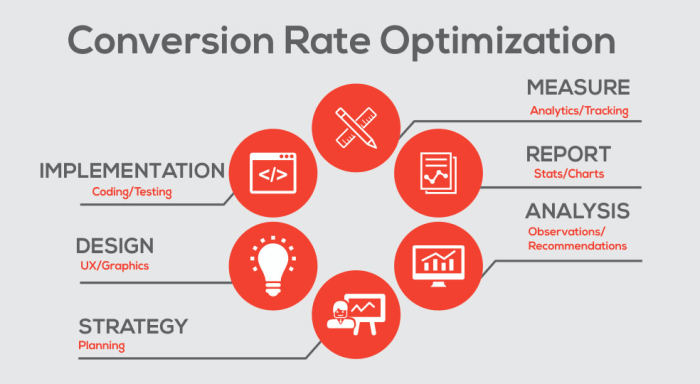Optimizing Conversion Rates dives into the world of online business success, shedding light on the crucial strategies that can enhance customer engagement and drive growth. From understanding conversion rates to crafting compelling call-to-actions, this topic explores the key elements that can make a significant impact on your digital presence.
Get ready to uncover the secrets behind user behavior analysis, website design optimization, and the power of social proof in this enlightening discussion on boosting your conversion rates to new heights.
Understanding Conversion Rates
In the world of online business, conversion rates refer to the percentage of website visitors who take a desired action, such as making a purchase, signing up for a newsletter, or filling out a contact form. It is a critical metric that indicates the effectiveness of a website in turning visitors into customers.
Common Conversion Rate Metrics
- Conversion Rate: The percentage of visitors who complete a specific goal on your website.
- Click-Through Rate (CTR): The percentage of users who click on a specific link or ad out of the total number of users who view it.
- Cart Abandonment Rate: The percentage of users who add items to their online shopping cart but leave before completing the purchase.
- Bounce Rate: The percentage of visitors who navigate away from the site after viewing only one page.
Importance of Optimizing Conversion Rates
Optimizing conversion rates is crucial for online success because it directly impacts the profitability and sustainability of a business. By increasing the percentage of visitors who convert into customers, businesses can boost their revenue and grow their customer base without necessarily increasing their advertising budget. It also helps in identifying areas of improvement on the website and refining the user experience to better meet customer needs.
Analyzing User Behavior: Optimizing Conversion Rates
Understanding how users interact with a website is crucial for optimizing conversion rates. By tracking and analyzing user behavior, businesses can make informed decisions to improve the overall user experience and increase conversions.
Methods for Tracking and Analyzing User Behavior, Optimizing Conversion Rates
- Utilize heatmaps: Heatmaps visually represent where users are clicking, scrolling, and spending the most time on a webpage. This data can help identify popular areas and optimize the layout for better user engagement.
- Implement scroll maps: Scroll maps show how far users scroll down a page before leaving. This information can indicate if important content is being missed and where adjustments are needed to keep users engaged.
- Use click tracking tools: Click tracking tools track the exact elements users are interacting with on a webpage. By analyzing this data, businesses can understand user preferences and make necessary changes to enhance the user experience.
The Importance of A/B Testing
A/B testing involves comparing two versions of a webpage to see which performs better in terms of user behavior and conversion rates. By testing different elements such as headlines, images, and call-to-action buttons, businesses can gather valuable insights into what resonates best with users. A/B testing is essential for analyzing user behavior and making data-driven decisions to optimize conversion rates.
Improving Website Design

Website design plays a crucial role in determining the conversion rates of a site. A visually appealing and user-friendly layout can significantly impact how visitors interact with your site and ultimately lead to increased conversions. Here are some tips for creating an effective website design that can help boost conversion rates:
Impact of Website Design on Conversion Rates
- Clear and concise navigation: Make it easy for users to find what they are looking for by organizing your content in a logical and intuitive manner.
- Mobile responsiveness: With the increasing use of mobile devices, having a responsive design that adapts to different screen sizes is essential for ensuring a seamless user experience across devices.
- Consistent branding: Maintain a consistent brand identity throughout your website to build trust and credibility with your audience.
- Optimized loading speed: Slow loading times can drive users away, so optimize your website to ensure fast loading speeds.
- Engaging visuals: Use high-quality images and videos to capture users’ attention and make your website more visually appealing.
Significance of Responsive Design
Responsive design is crucial for improving conversion rates across devices because it ensures that your website looks and functions well on any screen size. With more and more users accessing websites on mobile devices, having a responsive design can help you reach a wider audience and provide a better user experience. By optimizing your website for mobile, you can increase engagement and ultimately drive more conversions.
Crafting Compelling Call-to-Actions

When it comes to optimizing conversion rates, crafting compelling call-to-actions (CTAs) plays a crucial role in driving user action on your website. A well-designed CTA can guide visitors towards taking the desired action, whether it’s making a purchase, signing up for a newsletter, or downloading a resource.
Role of CTAs in Driving Conversions
CTAs are like signposts that direct users on what steps to take next on your website. They create a sense of urgency and encourage visitors to engage with your content or offerings. By strategically placing CTAs throughout your site, you can guide users towards conversion points and ultimately increase your conversion rates.
Best Practices for Creating Compelling CTAs
- Use clear and concise language that tells users exactly what action to take (e.g., “Buy Now,” “Sign Up,” “Download Here”).
- Make CTAs visually appealing with contrasting colors, bold fonts, and enticing design elements that grab attention.
- Create a sense of urgency by incorporating words like “Limited Time Offer,” “Act Now,” or “Exclusive Access.”
- Personalize CTAs based on user behavior or demographics to make them more relevant and engaging.
- Include compelling copy that highlights the benefits of taking the desired action to entice users to click.
Importance of A/B Testing CTAs
A/B testing is a crucial step in optimizing your CTAs for maximum impact. By testing different variations of CTAs against each other, you can determine which ones resonate best with your audience and drive the most conversions. This data-driven approach allows you to refine and improve your CTAs continuously, leading to better conversion rates over time.
Utilizing Social Proof
Social proof is a psychological phenomenon where people assume the actions of others in an attempt to reflect correct behavior for a given situation. In the context of websites, social proof can play a crucial role in influencing conversion rates by building trust and credibility with potential customers.
Examples of Social Proof Elements
- Customer reviews and testimonials
- Number of social media followers or subscribers
- Certifications and awards
- Case studies or success stories
Strategies for Effective Use of Social Proof
- Highlight positive customer reviews and ratings prominently on your website.
- Showcasing real-time statistics like the number of products sold or the number of customers served.
- Utilize influencer endorsements or celebrity testimonials to boost credibility.
- Display trust badges or security seals to reassure customers about the safety of their transactions.